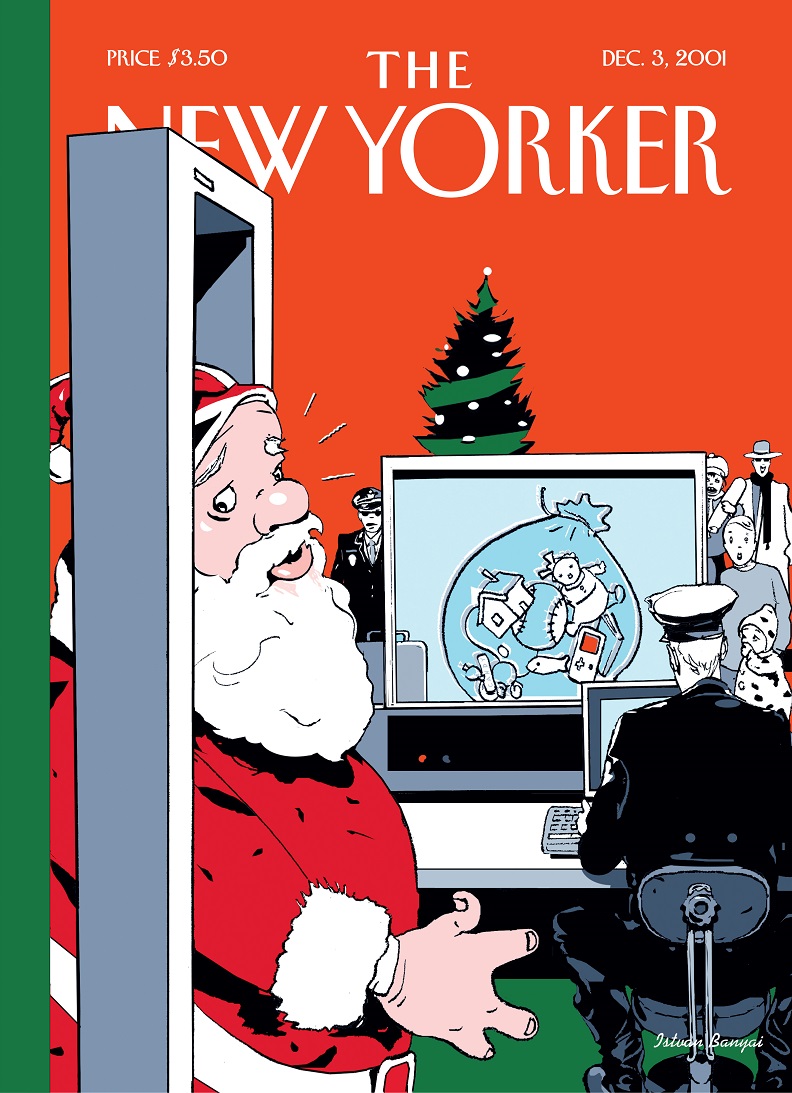Make a donation to the museum
Balancing National Security and Civil Liberties
Balancing National Security and Civil Liberties
- Grades 9 to 12
- Lesson Duration: One to two class periods
- Theme: Repercussions of 9/11
Essential Question: How does the balance between ensuring national security and protecting civil liberties shift after a terrorist attack?
Learning Goals
Students will explain the concepts of national security and civil liberties.
Students will examine multiple points of view expressed toward the balance between national security and civil liberties.
Students will question the balance between national security and civil liberties before and after 9/11.
Vocabulary
National security: This is a collective term for the defense and foreign relations of a country, as well as the protection of the interests of a country.
Civil liberties: These are the rights guaranteed by the laws of a country, as in the U.S. by the Bill of Rights.

“Holiday Travel,” 2001, Istvan Banyai, Courtesy of The New Yorker © Condé Nast
Activity
1. Project or distribute copies of The New Yorker cover titled, “Holiday Travel.” Click on the image to use the pinch and zoom feature for closer viewing.
2. Ask students to look at the cover and write down everything they notice on a sheet of paper or discuss observations in small groups.
3. After one minute, tell students you are going to work together to discover how this is connected to 9/11 based on their observations.
4. Lead a guided inquiry by asking the following questions:
- What people do you see on the cover? Who else do you see?
- Where does this take place? What makes you say that?
- What is happening on the cover? What makes you say that?
- When was this cover created? What makes you say that?
- How is this cover connected to 9/11?
5. Share the background information about the cover with students:
The U.S. Congress created the Transportation Security Administration in November 2001. Airports around the country implemented rigorous security screening procedures for passengers and luggage in an effort to prevent future attacks. Security measures were taken so seriously that The New Yorker suggested an exception could not be made even for Santa Claus and his bundle of holiday presents.
6. Ask students: What does this response by the U.S. government tell you about the concerns of the country immediately after 9/11?
7. Share the following information about the USA Patriot Act of 2001:
The USA Patriot Act of 2001 was passed on October 12, 2001, a month after the 9/11 attacks—it took only two days for the act to pass the House and Senate. The purpose of the act is to deter and punish terrorist acts in the United States and around the world by enhancing law enforcement investigatory tools, but specific parts are required to be reauthorized periodically by Congress. Some people believe it does not go far enough to enhance national security while others believe it goes too far by violating civil liberties.
8. Divide students into groups and distribute the debate in the House of Representatives on the USA Patriot Act of 2001 to one half of the groups and the debate in the Senate on the USA Patriot Act of 2001 to the other half. Direct students to draw a line down the center of a piece of paper, labeling one side “National Security” and the other “Civil Liberties.”
9. Ask students to read the excerpts and record points made by members of Congress that support national security in the column with that title and points that support civil liberties in the other. While students are working, tape signs with the words “Civil Liberties” on one side of a wall, and “National Security” on the other.
10. After 10 to 15 minutes, ask students to share the points they found under each category. After summarizing the arguments from the House of Representatives and Senate on both sides of the issue, pose the question: Where would you fall in this debate in 2001?
11. Ask students to line up along the spectrum of where they think the correct balance is between the two ideas. For example, students who are strong supporters of national security above all else should stand directly under the “National Security” sign. Ask them to explain why they are standing in their location. After hearing supporting arguments, invite students to move if their opinion has changed or if they seem out of order after hearing other students’ reasoning.
12. Follow up with another lineup based on the question: Where do you fall in this debate today? Repeat the steps above. Conclude the line-up activity by asking: Do you think attitudes have changed on the balance of national security and civil liberties since 9/11? Why or why not?
13. Ask students to return to their seats and play the clip 13:57-15:17 excerpted from the program “New York Stories: Sonia Sotomayor.” In this clip, Associate Justice of the Supreme Court of the United States Sonia Sotomayor reflects on the immediate effects of 9/11 and how they continue to be relevant today.
14. Conclude by asking students: How does this balance between national security and civil liberties manifest itself today? (Examples: travel ban, border security, the Patriot Act/Freedom Act, social media monitoring, smartphone encryption.) Can you think of another time in history when national security and civil liberties have come into conflict? (Examples: Japanese internment, Pentagon Papers, Chinese Exclusion Act.)